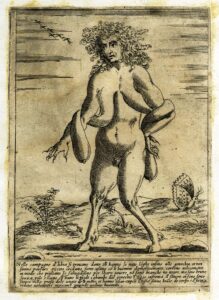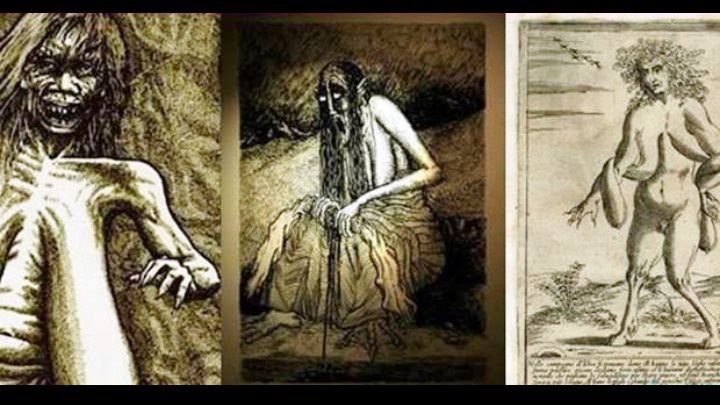Table of Contents
Who is Wewe Gombel?
Wewe Gombel creature is a figure from Indonesian folklore. The story of Wewe Gombel is often used as a cautionary tale to scare children. According to the legend, Wewe Gombel is a female ghost or spirit who kidnaps children, especially those who are disobedient or misbehave. It is said that she takes the abducted children to a remote place and raises them as her own.
The name “Wewe Gombel” is derived from the Javanese language. “Wewe” is a term for a female figure, and “Gombel” refers to a secluded or hidden place. The legend of Wewe Gombel is often told to warn children against wandering off alone or misbehaving, as a way to instill discipline and obedience.
Like many folklore characters, the details of the Wewe Gombel legend may vary across different regions and communities in Indonesia. It is important to note that folklore and legends often serve cultural and educational purposes, conveying moral lessons to the audience.
Origin
The origin of the Wewe Gombel creature legend is rooted in Indonesian folklore, particularly in Javanese culture. The legend has been passed down through generations via oral tradition, and various versions of the story exist across different regions in Indonesia.
The character of Wewe Gombel is often associated with the cultural emphasis on discipline and obedience in raising children. Parents and elders use the story as a cautionary tale to encourage good behavior in children. The threat of Wewe Gombel’s abduction serves as a deterrent, warning children against disobedience and wandering off alone.
Physical Description

The physical description of Wewe Gombel can vary in different retellings of the legend, but there are some common features associated with this mythical figure. Keep in mind that folklore allows for a degree of creative interpretation, so details may differ across different sources. Here is a general portrayal of Wewe Gombel:
Appearance: Wewe Gombel is often depicted as a tall, slender, and eerie woman. She may be described as having long, disheveled hair that covers her face, obscuring her features.
Clothing: Wewe Gombel is said to wear a traditional Javanese kebaya, a type of blouse, and a batik sarong. The clothing may appear old and worn, adding to the ghostly and mysterious aura.
Behavior: Wewe Gombel is associated with secluded places such as graveyards or abandoned buildings. She is said to roam these areas, especially at night, searching for disobedient or misbehaving children.
Voice: In some versions of the legend, Wewe Gombel is believed to mimic the voice of a child’s mother or use a soothing voice to attract and deceive children.
Abduction: Wewe Gombel’s main role in the legend is to kidnap children who are disobedient or stray too far from home. She takes them to a hidden place, where she supposedly raises them as her own.
Personality
The personality traits attributed to Wewe Gombel creature are consistent with her role as a cautionary figure in Indonesian folklore. While the details may vary, here are some common personality characteristics associated with Wewe Gombel:
Mysterious and Eerie: Wewe Gombel is often portrayed as a mysterious and eerie figure. Her appearance and behavior contribute to a sense of fear and apprehension, especially when she is encountered in secluded or dark places.
Maternal Deception: In some versions of the legend, Wewe Gombel is said to use a soothing voice, mimicking that of a child’s mother, to attract and deceive her victims. This deceptive maternal approach adds a sinister element to her character.
Disciplinarian: Wewe Gombel is a disciplinarian figure in the folklore, targeting disobedient or misbehaving children. The threat of abduction by Wewe Gombel serves as a cautionary tale to encourage good behavior and obedience.
Protector of Secluded Places: Wewe Gombel creature is often associated with specific locations, such as graveyards or abandoned buildings. She is considered a guardian or protector of these secluded places, and her presence is a warning to those who may venture into such areas.
Kidnapper of Children: The primary role of Wewe Gombel in the folklore is to kidnap children who do not adhere to societal norms or wander too far from home. This aspect of her personality reinforces the moral lessons intended by the folklore.
Explanation of the Myth

The myth of Wewe Gombel serves as a cautionary tale in Indonesian folklore, particularly within Javanese culture. The narrative typically revolves around the mysterious and ghostly figure of Wewe Gombel, who is said to roam secluded areas, such as graveyards or abandoned buildings, searching for misbehaving or disobedient children. The myth aims to instill discipline, obedience, and respect for societal norms among children.
Explanation of the myth:
Discipline and Obedience: The central theme of the Wewe Gombel myth revolves around the importance of discipline and obedience among children. Parents and elders use the character of Wewe Gombel as a means to emphasize the consequences of disobedience and misbehavior.
Abduction of Children: Wewe Gombel creature is portrayed as a ghostly figure who kidnaps children, particularly those who stray too far from home or engage in disobedient behavior. The threat of abduction by Wewe Gombel is meant to frighten children into following rules and staying close to their families.
Fear of the Unknown: The myth plays on the fear of the unknown, especially in dark and secluded places associated with Wewe Gombel. The eerie atmosphere created by the legend is designed to evoke a sense of caution, discouraging children from exploring such areas.
Maternal Deception: In some versions of the myth, Wewe Gombel is said to use a deceptive maternal approach by mimicking the voice of a child’s mother. This adds an element of betrayal and deceit to the narrative, reinforcing the idea that danger can come from unexpected sources.
Cultural Values: The Wewe Gombel myth reflects cultural values and norms, promoting a sense of community, family, and respect for authority. By incorporating these values into the narrative, the myth becomes a tool for socialization and cultural transmission.
In essence, the Wewe Gombel myth functions as a cultural mechanism to shape the behavior of children and reinforce societal expectations. The fear of Wewe Gombel’s abduction is a powerful motivator for children to adhere to cultural norms, stay close to their families, and avoid disobedient behavior.
Wewe Gombel in Modern Usage and Symbolism
While Wewe Gombel originated as a traditional figure in Indonesian folklore, its presence has extended beyond the realm of ancient stories and has found a place in modern culture. Here are some ways in which Wewe Gombel is utilized in contemporary contexts:
Cultural Icon: Wewe Gombel has become a cultural icon in Indonesia, often making appearances in various forms of media, including literature, film, and television. Modern storytellers may reinterpret the myth or use it as inspiration for creative works.
Entertainment: The character of Wewe Gombel is sometimes featured in horror films, TV shows, and other forms of entertainment. These adaptations may take creative liberties with the original myth to suit the preferences of modern audiences.
Tourism: In some regions, the legend of Wewe Gombel is leveraged for tourism purposes. Locations associated with the myth may attract visitors curious about the folklore, leading to the development of themed attractions or events.
Internet and Social Media: Wewe Gombel has found a presence on the internet and social media platforms. Memes, illustrations, and discussions related to Wewe Gombel may circulate online, contributing to its continued popularity and relevance.
Educational Tool: The myth of Wewe Gombel remains a useful educational tool for parents and educators. The cautionary tale is employed to teach children about discipline, obedience, and the consequences of risky behavior.
Symbolism:
Childhood Fears: Wewe Gombel symbolizes the fears that children may have about the unknown or supernatural. The myth taps into common childhood fears to convey important moral lessons.
Maternal Betrayal: The deceptive maternal approach attributed to Wewe Gombel can symbolize the potential dangers that may come from unexpected sources. It underscores the importance of vigilance and caution, even in familiar settings.
Cultural Values: Wewe Gombel continues to symbolize cultural values and societal expectations. The myth reinforces the importance of family, community, and adherence to cultural norms.
Adaptability: The enduring presence of Wewe Gombel creature in various forms of media and its adaptation to modern contexts symbolize the adaptability of folklore and traditional myths. These stories can evolve and remain relevant across generations.
Wewe Gombel has evolved from a traditional folklore character into a multifaceted symbol that is used in entertainment, tourism, and education. Its continued presence reflects its cultural significance and its ability to resonate with both traditional and contemporary audiences.
Similar figures
Various cultures around the world have folklore and mythology featuring entities with characteristics similar to Wewe Gombel:
La Llorona (The Weeping Woman) – Latin America: A ghostly woman who weeps for her lost children and is said to kidnap or harm other children as a form of punishment.
Babadook – Australian Folklore: A supernatural entity from Aboriginal folklore, often associated with punishment for disobedient children. It gained recognition in the modern horror film “The Babadook.”
Slender Man – Internet Mythos: A fictional, tall, and faceless humanoid figure that originated as an internet meme. It is sometimes associated with the abduction of children.
Chupacabra – Latin American Folklore: A mythical creature believed to attack and drink the blood of livestock, it shares the theme of a mysterious and threatening entity.
Krasue – Southeast Asian Folklore: A female ghost with a detached, floating head and trailing organs, known for terrorizing communities, especially during nighttime.
Yūrei – Japanese Folklore: A type of ghost or spirit in Japanese mythology, often depicted as a vengeful figure seeking retribution. Some stories involve them harming or abducting children.
Boogeyman – Global Folklore: A creature used by various cultures to frighten children into good behavior. The Boogeyman is a generic term for a mythical creature that punishes misbehaving children.
These figures share certain characteristics, each culture has its unique storytelling traditions and moral lessons associated with these entities.
Wewe Gombel FAQ
What is Wewe Gombel?
Wewe Gombel is a mythical figure from Indonesian folklore, particularly in Javanese culture. It is often depicted as a female ghost or spirit who roams secluded places, such as graveyards or abandoned buildings, and is said to kidnap disobedient or misbehaving children.
How to pronounce Wewe Gombel?
The pronunciation of "Wewe Gombel" in Indonesian is approximately "Weh-weh Gom-bell." The "e" in "weh" is pronounced like the "e" in "bed," and the "o" in "gombel" is pronounced like the "o" in "go."
What does Wewe Gombel mean?
The term "Wewe Gombel" is derived from the Javanese language. "Wewe" is a term for a female figure, and "Gombel" refers to a secluded or hidden place. So, loosely translated, Wewe Gombel means a female spirit associated with secluded or hidden locations.
Is Wewe Gombel good or bad?
Wewe Gombel is typically portrayed as a figure with negative connotations in folklore. It is a cautionary character, and its role is to instill fear in children as a means of promoting good behavior and obedience. Wewe Gombel is often associated with the abduction of children who do not follow societal norms, emphasizing the consequences of disobedience. In the context of the folklore, Wewe Gombel is considered "bad" as it represents a potential threat to misbehaving children.




